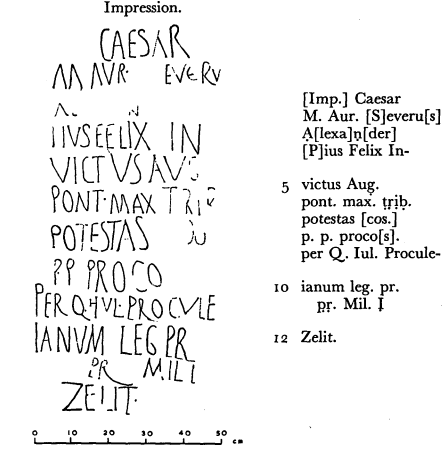No CrossRef data available.
Published online by Cambridge University Press: 23 December 2013
The two stones described below were discovered by the writer during journeys in Pontus made in the summer of 1958, as joint-scholar of the British Institute of Archaeology at Ankara. It is hoped to publish shortly the remainder of the material recorded in that and in the following year. 1. Zile, lying inside the castle. Milestone, much weathered.
H. c. 1·50; letters 0·03 to 0·08; between lines c. 0·03.

For two other milestones of Severus Alexander from the Zela–Sebastopolis road see F. Cumont in CRAI. 1905, p. 347 f. One of these was found 2 km. to the south-east of Zile and its text bears a strong similarity to that published here; a comparison of the two is illuminating for both. I shall refer to the stone published by Cumont as “the Ağbaba stone”, as it was evidently found close to Ağbaba Tepesi, and to the stone published here as “the Zile stone”.
1 My thanks are due to Mr. Seton Lloyd, the Director of the Institute, and to Mr. James Mellaart, the Assistant Director, for help and advice over two seasons in Turkey, and more especially to Mr. Michael Gough (who has also read this article) for his continued assistance and encouragement over a number of years. I should also like to thank the various members of the Turkish Department of Antiquities who have helped me on my way through northern Anatolia.
2 CRAI. 1905, p. 348Google Scholar.
3 REG. XVII (1904), p. 334Google Scholar.
4 CRAI. 1905, p. 348, n. 1Google Scholar.
5 Stephanus Byzantius s.v. ![]() .
.
6 CRAI. 1905, p. 349 f.Google Scholar
7 For an example of a milestone that actually records the boundary of a city territory see AM. XXXIII (1908), p. 152, no. 7Google Scholar.
8 For an example see under 2.c below, p. 138.
9 AE. 1922, No. 129.
10 CIL. III, 6906Google Scholar = 12169, 6954 = 12211,? 6939 = 12187.
11 BCH. XXXIII (1909), p. 27Google Scholar.
12 CIL. III, 6749Google Scholar = 6894 = 1418416.
13 Studia Pontica, II (1906), pp. 195–6Google Scholar. BCH. XXXIII (1909), p. 27Google Scholar.
14 Tabula Peutingeriana, X, 1–2Google Scholar.
15 Ramsay, W. M., The Historical Geography of Asia Minor, (London, 1890), p. 261Google Scholar.
16 op. cit., p. 260, note.
17 Studia Pontica, I (1903), p. 33Google Scholar.
18 op. cit., p. 260, note.
19 op. cit., p. 45.
20 Studia Pontica, II (1906), p. 256Google Scholar.
21 CIL. III, 1418439Google Scholar.
22 CIL. III, 307Google Scholar.
23 BCH. XXXIII (1909), p. 27Google Scholar.
24 Mél. Beyrouth, III (1908), p. 441, No. 2Google Scholar.
25 Studia Pontica, I (1903), pp. 55 and 72Google Scholar.
26 Mél. Beyrouth, III (1908), p. 439 fGoogle Scholar.
27 Tabula Peutingeriana, X, 1–2Google Scholar.
28 “Beyaz altın.” The use of this expression makes it reasonably certain that the grave is genuine and not the invention of a zealous host; the precious objects—one gold diadem, six cups and three pitchers of electrum, and other metal vessels—and the associated pottery are said to have gone to Ankara, apparently through official channels.